Change your mind. Change our world.
by Dmang8
This work has been commented by 3 curator(s). Read the comments
Title
Change your mind. Change our world.
Headline
here come a headline!
Concept author(s)
Me
Concept author year(s) of birth
22/10/91
Concept author(s) contribution
I did it all.
Concept author(s) Country
Australia
Friendly Competition
Competition category
Visual communication practice
Competition subcategory
static
Competition field
academic
Competition subfield
student
Subfield description
Griffith University Design
Check out the Debt. 2012 outlines of Memefest Friendly competition.
Description of idea
Describe your idea and concept of your work in relation to the festival outlines:
The campaign will function by making the public aware of shocking statistics and realties about the way the world operates. This will encourage debate, change opinions and foster inquiry into the way society runs as a whole. By changing public opinion, individuals are more likely to be involved in and advocate for sustainable economic management. Government policies are more likely to change when large amounts of people are engaged in a similar political discourse.
The direct action component will work because it will use two strategies with a proven history of creating change. The first method is microlending. Microlending will be encouraged through first making viewers aware of the issue by making shocking statistics & information available, and then alerting them to existing micro lending institutions such as KIVA and ACCION where they can donate to promote change. Microlending is a very direct way of donating as funds are given straight to those in need instead of being wasted in administration fees and advertising.
The other method is holding offenders (companies, people, institutions, governments) to account through petitions, letters and signature gathering. Signatures do make a difference. Petitions work by putting the offending parties under pressure and making them know that the public is aware of what they are doing. In 1978, the British Anti-Apartheid Movement delivered petitions signed by 45,000 persons to the United Nations to free Nelson Mandala. In 1980, A petition sponsored by Sunday Post received over 86,000 signatures. In 1984, three United States organizations presented to the United Nations petitions for the release of Nelson Mandela signed by over 34,000 persons. In 1990 Nelson Mandela was freed. Amnesty International has countless success stories on their web site such as: Ma Khin Khin Leh set free from Myanmar after petition (2009), Ye Guozhu set free in China after petitions were delivered (2008) Sami Al Hajj was released from Guantanamo after Amnesty petition (2008). Organizations such as Getup and Avaaz base most of their campaigns on petitions and signature gathering.
What kind of communication approach do you use?
The communication approach that has been used is a campaign that targets an audience through public (widespread) and targeted (through mailing lists/interested parties) print and online campaign items. The campaign strives to educate individuals and change their minds, and also encourage them to participate in changing the world through microlending, signing petitions and sending postcards to some of the worlds most unethical and wealthy corporations. I have been influenced in one of my outcomes very strongly by Stefan Sagmeister, a designer who I have observed as always seeing design “playing important roles socially and politically as well as economically”, (Kimbell, L, 2011) which is essential to good design.
What are in your opinion concrete benefits to the society because of your communication?
The benefits to society that have come about because of this campaign is education, increased corporate scrutiny and if the campaign is successful more people participating in microlending. By changing public opinion and educating people, individuals are more likely to be involved in, and advocate for sustainable economic management. Government policies are more likely to change when large amounts of people are engaged in a similar political discourse. The campaign will bring about concrete benefits to society because it will use and encourage two strategies with a proven history of creating change. The first method is microlending. Microlending will be encouraged through first making viewers aware of the issue by making shocking statistics & information available, and then alerting them to existing microlending institutions such as KIVA, ACCION, opportunity.org, and the Grameen bank, where they can donate to promote change. Microlending is a very direct way of donating as funds are given straight to those in need instead of being wasted in administration fees and advertising. The other method is holding offenders (companies, people, institutions, governments) to account through petitions, letters and signature gathering. Signatures do make a difference. Petitions work by putting the offending parties under pressure and making them know that the public is aware of what they are doing. Successful organizations such as Getup, Avaaz and Amnesty International base most of their campaigns on petitions and signature gathering.
What did you personally learn from creating your submitted work?
I have been shocked by many of the statistics that I have found. I have learnt that debt does not affect one person in most cases but usually affects whole families and groups. I have learnt that debt can be thought of in many different ways, for example, financial, psychological, through passing ones genes on (with chemically altered dna), or through inter-generational trauma. Through researching some of the most unethical corporations in the world (as defined by Covalence, a Swiss organization) I have found that these corporations often leave long lasting inter-generational, financial and psychological debts. I have found that greed and corporations exclusive focus on their profits almost always to a long lasting debt on someone else. I have also learnt that as eye magazine’s first thing first manifesto states,“Consumerism is running uncontested; (and) it must be challenged by other perspectives expressed, in part, through the visual languages and resources of design.” I have also learnt the important role designers can play in society as “interpreters of changes in culture who then create new kinds of cultural form” (Kimbell, L, 2011).
Why is your work, GOOD communication WORK?
My work is good communication work because it is an accessible, interesting, environmentally responsible and socially responsive critique of society that will lead to more education and positive change. Van Toorn, J (2010), states that really committed visual journalism “needs a vision to ensure moments of genuine human exchange”. Similarly, s/he denounces bad visual communication as “resulting in messages without any conceptual flesh on the bones”. My work is good communication work because it has both a vision and a message.
Where and how do you intent do implement your work?
I intend to implement my work after gaining more marketing information and financial support. Both of these factors are important because I currently do not have a viable means to finance this campaign (printing, delivery costs etc), and also I would need to find some way of getting the print collateral to interested parties through mail-outs/emails instead of random deliveries. Alternatively, many aspects of this campaign could be converted into an online campaign, with those interested in participating printing out items themselves or emailing unethical corporations as opposed to normal mail.
Did your intervention had an effect on other Media. If yes, describe the effect? (Has other media reported on it- how? Were you able to change other media with your work- how?)
My work as yet has not had any effect on other media.
Curators Comments

Scott Townsend
I like what this is about as a "systems design project," which the author refers to as a campaign. There is an interesting mix of information design targeted in different ways and direct action as a form of persuasion, (for example the Monsanto packaging).
Constructively, what may help connect these various points of audience contact would be to incorporate some of the techniques being used to look at user experiences + experience design (not "UX"). There is a bit of a disconnect between one "design as activity" and another at this point. I think that this is touched upon by the author in the section "where + how do you intend to implement your work" which is about, in part, how design artifacts and their use (and user comprehension/understanding) get disseminated to an audience, how they connect and reinforce each other as collateral material, how do they work through time and as a kind of implementation of a program, etc.
The level of research is very impressive: the idea of looking at user experiences across time and in a particular community is a possible additional research component.

Shoaib Nabi
"Change your mind. Change our world." A simple statement that has a powerful impact based on well thought-out research and visual communication design. You have a very solid proposal for the targeted audience and the promotional materials and methods outlined in your answers to the Memefest questions reflects and gives me evidence of the level of engagement you have had with the theme for this years competition. I see the inspiration of Sagmeister in your work. You may want to make yourself also familiar with the work of Bruce Mau if you are not. Both these designers have much interest in social issues and great advocates for change. You have understood well the power of a slogan, an insignia, a mark and have aligned yourself with the likes of Occupied Wall Street Movement. It is evident that you have learnt a lot from this project and much aware of the statistics and the consumption of debt and its victims. "My work is good communication work because it has both a vision and a message." I would add to this that your work is also backed by facts and data not based on perceptions or mis-placed ideology.
I would encourage you to develop a website or a blog for your work so you can generate and show evidence of support for this cause that could lead to financial sponsorships. Often it is more effective to get your audience through the internet and build on that. This could be a cheaper alternative for you currently and you may get people who support your cause to add on their web pages a link to "Change your mind. Change our world." Printed brochures, no matter how attractive they are could easily be disposed and might be getting archaic. I would encourage you to also think of time based mediums to spread your message.
I enjoyed your Apple flyer but you don't want it to get gimmicky — remember the cause you are standing for demands wider exposure and not limit yourself in anyway. Good Luck.

Kevin Yuen Kit Lo
This is an incredbily complete, well-researched and targeted social communications campaign. The strategic, tactical and design decisions are well-thought out and presented. The information graphics and factual comparisons work very well to draw attention and explain the issues, while the calls to further action are very clear. I really appreciate the amount of time, thinking and effort that must have gone into producing and illustrating this concept, and I think it achieves the goals set out by the brief. All in all, this is a very professional project, that clearly demonstrates the concept of design for social good.
All this being said, my criticism of this project in the context of memefest also lies with this "professionalism". Though I do fully appreciate how this project could work in a real world context, by encouraging microlending and civic engagement (which in and of themselves are good things), the project does not question the inherent problematics/discourse of contemporary capitalism and the true nature of debt as explored in Graeber's text. It does encourage us to change the status quo, but only within the prescribed limits of a dominant ideology that in my opinion (and likely Graeber's) , is quite fundamentally flawed. Given the current state of the economy, I'm unsure that progressive social change can be achieved by the strategies you're seeking to encourage with this project.
This is nonetheless a very strong design project, and I am very much behind its eventual implementation. You are clearly a talented and rigorous design thinker, so I would encourage you in future endeavours to also try applying these skills in more critically imaginative ways, to projects that beyond changing our behaviour, might change us.





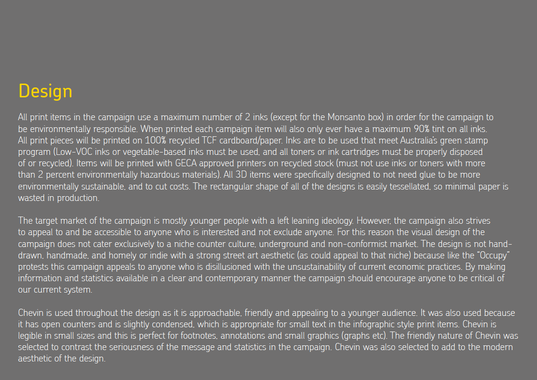












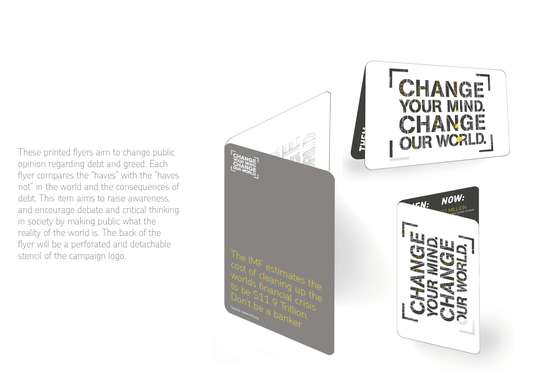
















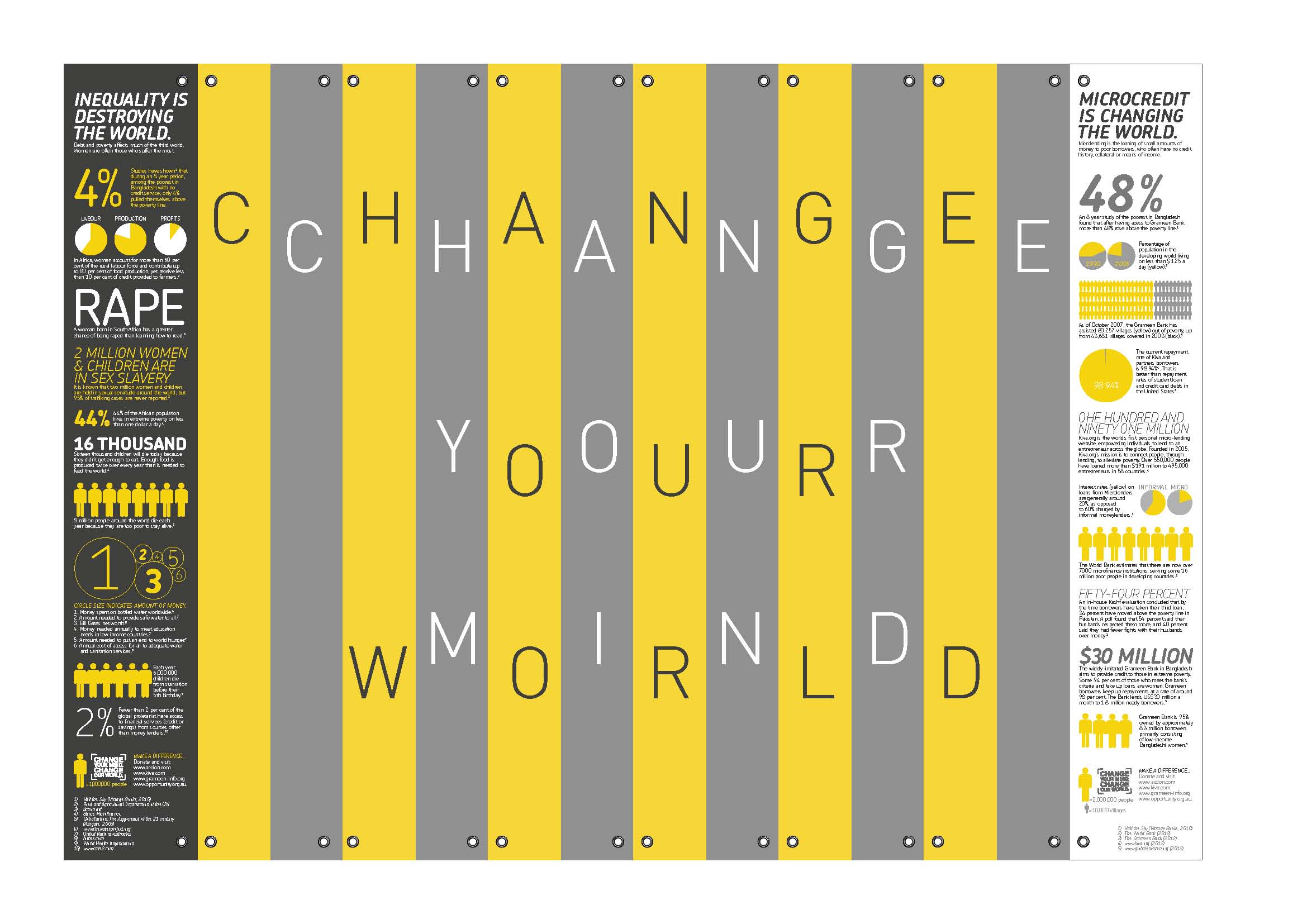






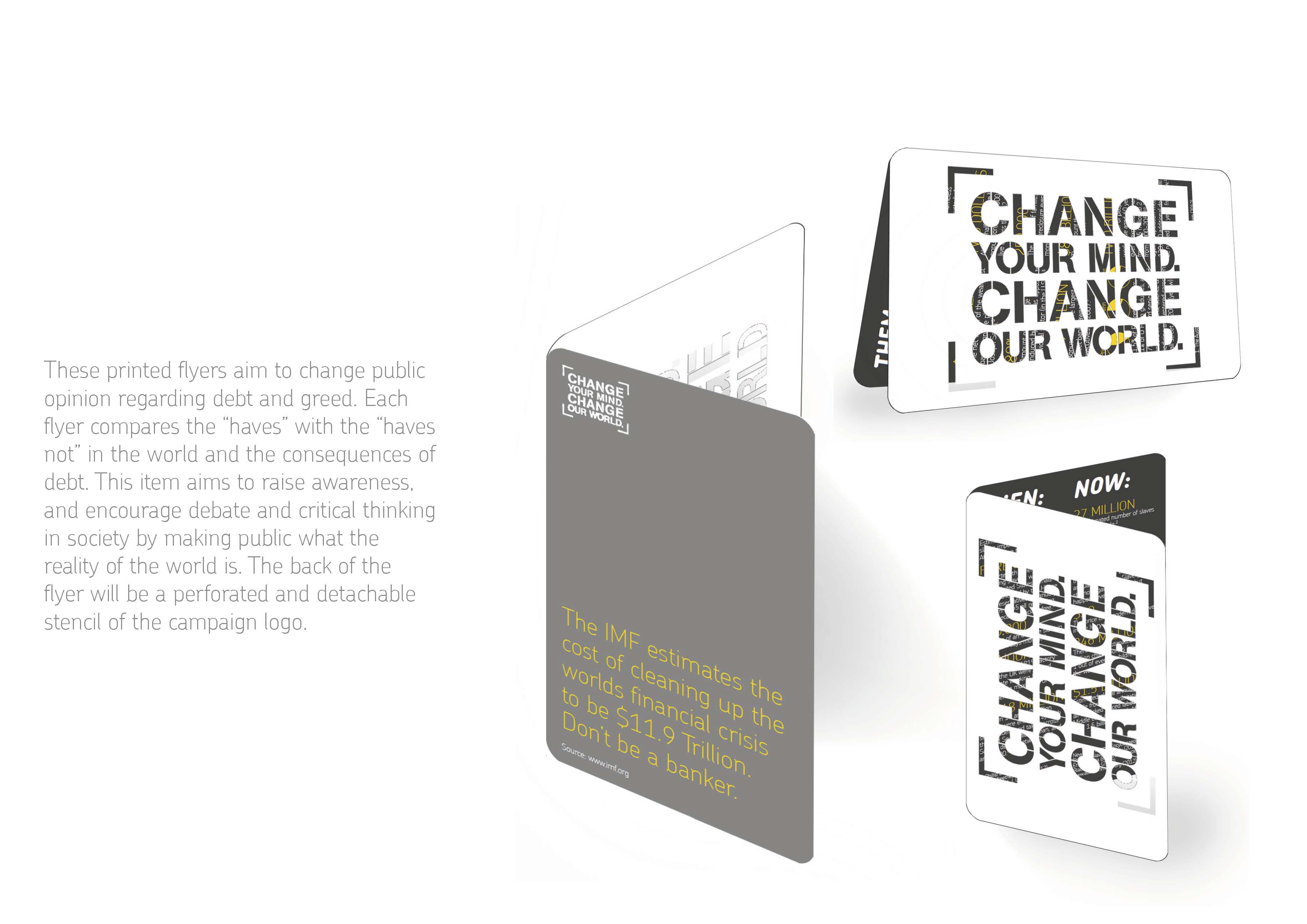



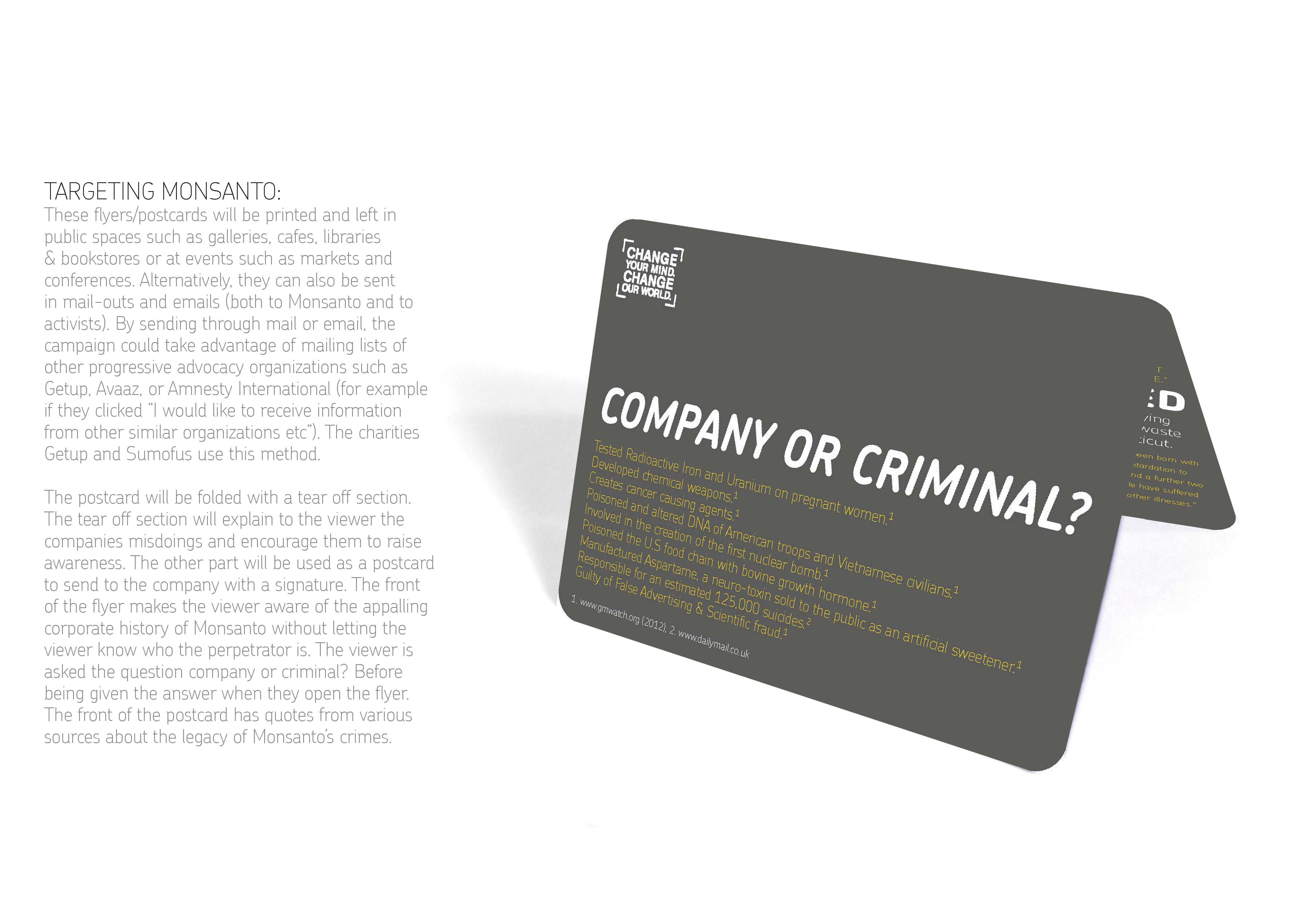


12 years, 11 months ago
I think from the feedback that it is clear that the mediums I have used for this project have not been the most appropriate. It seems that moving online as I had considered looks to be the most effective means of gaining more exposure, financial support and interest in the cause. It would be more up to date and I recognise that the print collateral is too disposable and archaic for this campaign. Operating thorough a blog or website would be the most cost effective means of targeting and maintaining a dialogue with interested parties and finding a wider audience. Moving online could also provide a means of monitoring user experiences through time and through different groups of people as well, which I agree would add to the project.
You have all commented that you were impressed with my level of research. Research was not a chore for me at all because I was very interested in the research and feel that more people need to know the facts of the way the world operates. The majority of people (especially my age) are too distracted and occupied by technology, popular culture, controlled and biased mass media and an unhealthy obsession and need for validation from social media to even understand the basics of modern history or sociology and that is a problem/ignorance that makes me angry. Shoaib, you have written that my work is “backed by facts and data not based on perceptions or mis-placed ideology.” I feel that this is an important point. I deliberately wanted to concentrate on unbiased facts because people can have ideological disagreements, but if objective, corroborated facts about society are stated in a clear manner, they cannot reasonably argue with them (although that probably wont stop them trying). The research I have found, for example “A girl in south Africa is more likely to be raped then learn to read’, “16 thousand children die daily even though enough food is produced twice each year to feed the world”, or observing the unfair division of labor and profits for African women should outrage everyone. Everyone should be passionate about learning from and about this information. If everyone knew and understood the facts they surely would be furious and want to change the way the world operates, and that is why design is such a powerful and important tool to make information more accessible.
A valid criticism was from Kevin when he said that “the project does not question the inherent problematics/discourse of contemporary capitalism and the true nature of debt as explored in Graeber's text”, and that the project “does encourage us to change the status quo, but only within the prescribed limits of a dominant ideology that in my opinion (and likely Graeber's), is quite fundamentally flawed.” I agree that the dominant ideology of the world is fundamentally flawed and that the approach I have taken has decreased the power of the campaign. I didn't set these limits on the campaign because I felt that a system of almost global advanced capitalism and globalisation is perfect or even good. The project was developed in such a way because I thought about it from a cynical perspective. Because the majority of the world is part of a system of advanced capitalism, it is unlikely to change due to this campaign, and it was a more realistic and pragmatic solution to at least try to educate people and encourage some form of direct action within the limits of the system we are currently in. I also wanted to have a broader audience that wasn't immediately turned off because they feel their ideology is different or conflicting to ‘progressive’ or ‘left-wing’ ideas. That is another one of the reasons I relied on unbiased facts that are not political or ideological. I do accept that a more comprehensive/critical approach towards the global economic model could have led to a stronger outcome and I’ll use this advice in future projects and through the continuing development of this project.
Shoaib, I believe I have had some exposure to Bruce Mau but I am now more familiar with his work, and his “Incomplete Manifesto for Growth” is also now blu-tacced to my wall.
Once again, thank you to you all for your very constructive feedback,
Darcy Mangan.